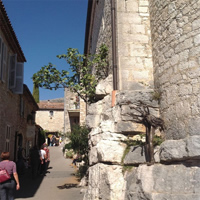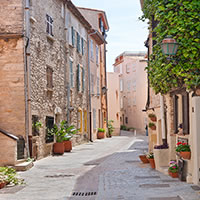French Riviera - Hill Towns and Villages

St Paul de Vence
St Paul de Vence is one of the oldest medieval towns on the French Riviera offering an appealing artsy scene built on a cozy hilltop setting with beautiful architecture and magnificent vistas of the lush countryside below. Well known for its many modern and contemporary art museums and galleries such as Foundation Maeght, the beauty of the surrounding areas has inspired numerous famous artists, painters, writers and poets. As you walk around the charming narrow streets of St Paul de Vence you will discover little shady squares, ancient fountains, gateways and porches, artists` and craft workshops, and many quaint restaurants and boutiques. The atmosphere is peaceful here, the residents are welcoming, and the views are magnificent.
Make sure to check out the prestigious Foundation Maeght gallery while here. The gallery offers world-class contemporary art and pleasant gardens. It is an unusual museum building that has been purposely made lowkey to allow the art to take center stage. Works by Fernand Legar, Joan Miro, Alexander Calder, Georges Braque, and Marc Chagall canbe found here.

Vence
The pleasant hill town of Vence, known as the `City of Art,` is a historic village with numerous interesting sights and monuments. The historic center`s layout is based on a Roman design encircled by an oval wall. The town offers a lovely setting full of beautiful flowers, atmospheric yet untouristy. There are lovely old churches and little squares tucked away in spots throughout the town, much appears as it did hundreds of years ago. Wander down Avenue Henri Matisse and explore the Chapelle Matisse (also known as the Chapelle du Rosaire des Dominicanes de Vence). Visit one of the many galleries, or simply explore and admire the sculptures and buildings around the town.
The town is not just about art; it has a great medieval history as well. There are five medieval ports that lead into Vence: Portail Levis, Porte du Peyra, Tour-Porte du Signadour, Porte du Faubourg ou Pontis, and Porte d`Orient. Don`t miss the Fountaine de la Foux, which supplies mineral water from La Fouxriver. Visitors have been known to take a jug-full of the pure water!

Eze
The 14th-century medieval village of Eze sits high above the sea offering fancy boutiques, steep cobbled streets, magnificent views and famous perfume outlets. It is the superstar of hill villages and probably the most visited in the region. Perched above the village on top of the mountain, the Jardin Exotique d`Eze boasts spectacular panoramic views of the Mediterranean and the hills below. Stone staircases and paths snake among sculptures, statues, and the countless species of plants and cacti indigenous to the climate of the Cote d`Azur. Since 1949, the ruins of an old chateau have been home to hundreds of different plants 1,400 feet above the sea. Make sure to pay a visit to the perfume outlets to watch the production process and shop the fragrance collections. The charming cobblestone streets filled with hot-pink bougainvillea contain galleries, perfumeries, boutiques, and artisans` shops beautifully set for leisurely strolling.
The curious name, Eze, derives from the Egyptian goddess, Isis. The ancient Phoenicians who once occupied this spot dedicated a temple to her. Eze was abandoned until the 1920s when the proper technology allowed for road systems and access to water.

Grasse
Grasse is a quaint medieval town located up in the hills to the north of Nice, the renowned capital of the world`s perfume industry since the 16th-century. Three-quarters of the world`s essences are produced here from thousands of tons of petals, including violets, daffodils, wild lavender, and jasmine. Visitors from all over the world enjoy the perfume museum and free tours of their perfume factories, but you will also want to take in the never-ending fields of lavender that dominate the area`s hilly landscape. Discover the fascinating historic town with beautiful streets and winding staircases packed with charming boutiques, fountains, picturesque squares with welcoming café terraces, and vaulted passageways. Grasse also offers 16th-century ramparts, medieval houses raised in the 17th and 18th centuries, superb private mansions (Hotel de Cabris, Hotel de Ponteves, Court de Fontmichel), numerous chapels and magnificent 18th-century villas.

La Colle-sur-Loup
Ideally located in a beautiful natural environment of oaks, olive trees and pines, lemon trees and perfume flowers, La Colle-sur-Loup is a village in the Provence of the olden times. You will enjoy the quality of the environment and the beauty of it`s natural areas. As you walk through the Canadel gate you will be immersed in the historic center of town with narrow alleyways and shady squares. The old town offers beautifully sculptured facades and carved doors, as well as lively shopping streets and cafes. Make sure to visit the river `Loup,` one the town`s main attractions, a peaceful and natural oasis and starting point for many excursions and water sports and great to enjoy during the hot summer months.

Mougins
The Medieval village of Mougins is perched on a hill surrounded by forests, such as the Valmasque forest with pines, olives, and Cyprus trees. It is located between Cannes and the back-country gateway town of Grasse with streets unlike the narrow streets found in most of the perched villages in the South of France, but circular in nature bringing you around in a circle as you explore. The village has been occupied since the pre-Roman period and has retained the shape of its origins, and some remains of its medieval heritage. Mougins has become known as a center of gastronomy with many fabulous restaurants including some with Michelin stars. The village is host of an annual `International Gastonomy Festival of Mougins`, a gastronomic event taking place every September. It is also packed full of art galleries and home of the classical art museum.
Located in the center of Mougins is a small courtyard decorated with a fountain and flowers and shaded by trees. Here you will discover a few small cafés where locals meet. One very attractive aspect of Mougins village is the trees that grow through the restaurant terraces in the main square.

Le Cannet
Le Cannet is located north of Cannes and was once a part of Cannes until 1777; the two cities form a single urban area. The town offers historical sites and cultural attractions. Some highlights include St Catherine`s church, completed in 1556; St Sauveur Chapel, including work by the artist Tobiasse; the Lovers` Wall, a 1990 fresco by Raymond Peynet and Guy Ceppa; on a monument fresco showing the family tree of the 140 families from Italy who founded Le Cannet in 1440. There are towers and chapels and winding streets with artists` work such as Bonnard and Bellini to be seen. Le Cannet also offers great restaurants and bars featuring outside dining with beautiful views of Cannes and the bay. The town is also famed for its orange wine, a must try during your visit!

Le Gaude
Le Gaude is a village situated on a small ridge between Vence and Cagnes-sur-Mer. You will appreciate this village for its low key atmosphere and quietness. The town is made for strolling with its narrow streets and fountains, as well as beautiful fauna and flora. On Wednesday and Saturday mornings you will be able to enjoy a market and taste the Mediterranean flavors. As you explore you`ll discover beautiful facades of houses which have been carefully restored. Marcel Pagnol, famous illustrious author/filmmaker lived here for 30 years, much to the pride of the local residents. A festival is dedicated to him each year in August. The town is host to a large complex specializing as a research center in I.T. agricultural economy and horticulture located on the banks of the Var river.

Opio
Opio is a tiny village perched on a low hill in the middle of a beautiful Mediterranean environment. In the heart of town you will find the town hall (Mairie), the 12th/15th century church and a few residential villas overlooking the golf courses and farmlands on the plains east of Grasse. Due to an exceptional micro-climate, roses and jasmine are farmed here for the Grasse perfume industry. Opio is widely recognized for its 15th-century olive oil mil, one of the few such mills still operating in the region.

Beausoleil
Beausoleil is situated in southern France, adjoining the Principality of Monaco (located a half a mile to Monaco). The town was formerly known as Monte-Carlo-Superieur. This hillside town is surrounded by the Tete de Chien and Agel mountains and consists of Belle Epoque houses with ornate entrances. Some interesting attractions you will find in Beausoleil include the Gustave Eiffel covered market, St Joseph`s Sanctuary (a church with ornate stained-glass windows) and the Fontdivina Fountain and Wash House.

Roquebrune-Cap-Martin
Located between Monaco and Menton, the village of Roquebrune is situated on a rocky outcrop high over the Mediterranean just east of Nice. The medieval village is dominated by the 10th-century chateau-fort and offers narrow streets, stone steps, and deep vaulted passages. The history is everywhere showcasing in the old stone and architecture. As you stroll through the village you will find lovely little squares and fountains, wrought-iron balconies and charm all around. The town is a tourist town as well as residential. Within the commune of Roquebrune-Cap-Martin just below the village is a wooded peninsula on the Mediterranean. Here you will find shops, the beach, a train station and some campsites.